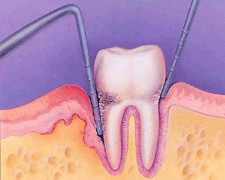المقالات
Bone Grafting

Sometimes your body needs the assistance of modern science to repair or heal itself. This is the case when you've lost bone from your jaw. To repair your jaw, we can perform a surgical procedure called bone grafting, in which we replace missing bone with other natural bone or artificial bone. The area from which the bone was lost is frequently called a "bony defect." A bony defect may be the result of periodontal disease, tooth removal, trauma, a cyst, or long-term tooth loss. A bone graft not only replaces some of the bone that's missing from your jaw, it also stimulates your body to grow new bone tissue.
To place a bone graft, we first make sure the area is completely numb, and then we gently separate the gums from the bone or tooth. If a tooth is present in the grafting site, we'll use a process called root planing to remove all of the plaque and tartar from the root surfaces of the tooth. This ensures that the area is free of harmful bacteria.
We then sculpt the surrounding bone to the desired shape and place the grafting material into the bony defect. We have several options for grafting material: your own natural bone; bone tissue from another source; or artificial bone. After the graft is placed, your gums are repositioned over the graft site and secure the site with sutures.
Over the course of 3 to 9 months, your body works to repair the grafted site, growing new soft tissue and bone. This new bone growth strengthens the area by connecting your existing bone with the bonegraft material we placed during the procedure. Sometimes we'll take another step called guided tissue regeneration. In this case, a special membrane is placed over the graft site to prevent unwanted tissue from growing and to enhance normal bone growth.
Bone grafting has many benefits. It replaces lost or missing bone, fills in pockets of bone loss, and stimulates new bone and soft tissue growth. Though your body can't normally grow new bone on its own, new techniques and advanced bone grafting technology allow us to stimulate the re-growth of lost jaw-bone tissue, strengthen your tooth attachment and fill in the pockets of bone loss caused by periodontal disease.
